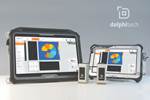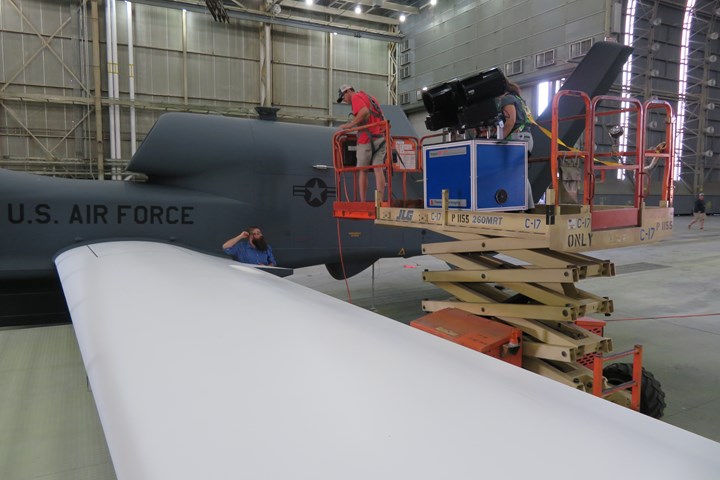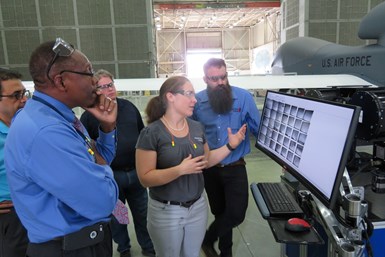NCMS report demonstrates thermography innovations for enhanced NDI capabilities
Technology brief highlights how thermographic signal reconstruction (TSR) has enhanced the readiness of aircraft in less time and at lower cost, with potential for use inspecting composites and metals.
The National Center for Manufacturing Sciences (NCMS, Ann Arbor, Mich., U.S.) has announced the publication of a new report featuring the benefits of large-standoff/large-area thermography (LASLAT), an advanced thermal imaging tool that has expanded the capabilities of non-destructive inspection (NDI). The technology brief highlights how NCMS’ collaborations with a thermography innovator and the U.S. Air Force (USAF) have enabled military aircraft maintainers to enhance the readiness of aircraft in less time and at lower cost than before.
According to the NCMS, over the past two decades, thermography has become a widely accepted method for NDI. Thermographic inspection can use either a component’s inherit heat flow (passive thermography) or an induced heat flow (active thermography) to reveal component abnormalities. Passive thermography is used to inspect objects from large distances, while flash thermography (a technique of active thermography) has primarily been limited to close-proximity distances. NCMS’ industry partner, Thermal Wave Imaging (Madison Heights, Mich., U.S.), has developed a method called thermographic signal reconstruction (TSR) that leverages the past success of close-proximity flash thermography and the large distance-to-target principle of passive thermography. The technology is reported to facilitate an unprecedented degree of sensitivity depth range, and resolution of subsurface defects.
A key advantage of the LASLAT system is its portability: Technicians can move the system directly to the aircraft, as opposed to larger systems that require taking the aircraft to another location. An infrared camera monitors surface temperature changes to detect subsurface defects or anomalies including delamination, disbonding, fluid intrusion, impact damage and other defects. Automated inspection routines eliminate manual positioning, and the system can cover an inspection area of 17 feet x 15 feet, at the rate of 7 square feet per minute.
The system can also scan an entire inspection area and then provide an aggregate subsurface map for review. Using data analysis tools in an accompanying software program, technicians can pinpoint the exact location and measurements of defects, and then produce an archive of inspection results over the service lifetime of an aircraft.
Through NCMS’s project, USAF has found that inspection of a large aircraft prop rotor blade that previously took roughly 10-14 hours to scan now takes three to four hours, and results in increased documentation and traceability for their inspections. Following the project, the system was employed by the Navy to inspect V-22 Osprey prop rotor blades. This change in inspection methods has produced an average savings of 625 labor hours annually.
While the NCMS project focused on military applications for the LASLAT system, it has many potential applications for other industries, particularly in the aviation and aerospace sectors. Its sensitivity and depth range would enable inspection of advanced composites as well as a variety of metal materials. Additionally, it could be applied in other industries with high-value assets, such as power generation, automotive, marine, electronics and more.
To read the entire NCMS report and learn more about the NCMS technology brief program, visit this link.
Related Content
-
VIDEO: AI, cameras and lasers for FOD detection
Virtek Vision demonstrates its Iris AI technology at CAMX 2024. It combines laser projection with machine learning software to detect foreign object debris during a composite layup.
-
Plant tour: Airbus, Illescas, Spain
Airbus’ Illescas facility, featuring highly automated composites processes for the A350 lower wing cover and one-piece Section 19 fuselage barrels, works toward production ramp-ups and next-generation aircraft.
-
Robotic NDT inspection solutions, services enhance multitasking capabilities
CAMX 2024: Matec Instrument Companies Inc. presents its range of nondestructive ultrasonic testing technologies, including robotic inspection systems for increased efficiency and reduced physical strain.













.jpg;maxWidth=300;quality=90)




